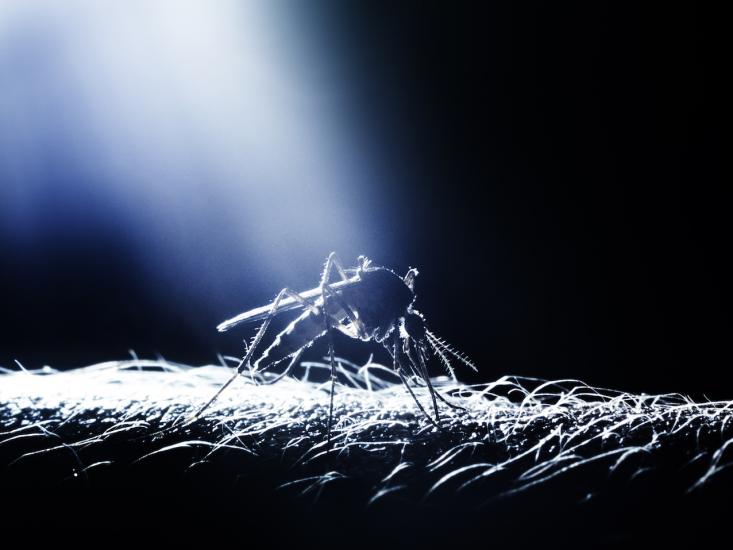The Nobel laureate Baruch Blumberg once estimated that malaria has killed half of the people who have ever lived. In 2015 alone, it killed almost half a million people, 70 percent of which were children. Today, about 3.2 billion people are, according to the World Health Organization, at risk of contracting it, most of whom are children and pregnant women.

It’s brought on by a blood parasite—about 50 times smaller than the width of a human hair—the most common and deadly of which is Plasmodium falciparum, which thrives in Sub-Saharan Africa. It rides on the needle-like mouth of a mosquito, known as a proboscis, until it gets injected into the bug’s next blood meal. If the victim happens to be human, the first symptoms from the attack are flu-like: fever, headaches, chills, and nausea. If these are left untreated the parasite can eventually cause a coma, permanent brain damage, or death. It has a knack for evading our immune system and our drugs. Our immune system is like a bouncer outside of club—and malaria’s the kid with a convincing fake ID. Our immune system protects us by identifying the molecules on an invader’s body, called antigens, but the parasite can change around its antigens, evading the body’s bouncers. “There’s been antimalarial drugs for a long time,” says Andrew Wargo, a pathogen ecologist at the College of William & Mary, “but they don’t seem to work very long because the parasite evolves resistance around them—it’s very good at doing that.” Mosquitoes have also evolved resistance to our latest insecticides, which means researchers are constantly playing catch-up.
Yet, in his final State of the Union address in January, President Obama said we have a chance to end malaria, “something I’ll be pushing this Congress to fund this year.” Is it realistic to expect an end to this horrendously resilient disease any time soon? It won’t be easy, and the road might not be as short as some are promising, but yes: Here’s why malaria’s reign could, in at least quarter-century, be at an end.
In the last 15 years malaria’s mortality rate has been cut by 60 percent globally, a “spectacular reduction,” say Graham Brown, an expert in infectious disease and Foundation Director of the Nossal Institute for Global Health at the University of Melbourne, and Stephen Rogerson, an immunologist at the University of Melbourne. “The time is ripe to re-double efforts.” With the World Health Organization and the European Medicines Agency’s approval of the first malaria vaccine—the first vaccine for any parasite ever—several African countries are now beginning trials. The vaccine is only effective against the P. falciparum species, and only works on about 30-40 percent of people, but it’s a big leap forward.
What’s more, like Obama, organizations like Malaria No More and Medicines for Malaria Venture have championed an end to the disease; plus, the Bill & Melinda Gates Foundation has contributed almost $2 billion since 2000 to end malaria. Last year, the African Leaders Malaria Alliance adopted a plan to eliminate the disease in Africa by 2030, and the Asia Pacific Leaders Malaria Alliance launched their own 2030 Malaria Elimination Roadmap. And it’s not like large areas haven’t eliminated malaria in the past. Although today it’s widely considered a third-world disease, malaria thrived in the U.S from the South East all the way up to Illinois, and in Europe until the early 1950s. In 1947, the Office of Malaria Control in War Efforts—which would eventually transform into the Center for Disease Control—began a campaign of heavy insecticide use and swamp and marsh draining to combat the disease. In only six years, the United Sates was declared malaria-free; a decade later it was wiped out in Cuba, too.
Even where eradication efforts fall short, notable benefits still result. In a 2015 study, Jeremy Barofsky, an economist at the Brookings Institution, and colleagues, showed that, in 1960, Uganda’s malaria eradication campaign immediately reduced the disease and as a result, they write, “raised educational attainment by about a half year for both males and females, increased primary school completion among females and generated an almost 40% rise in the likelihood of male wage employment.”
Today, the use of preventive measures—like insecticide-treated bed nets, which keep the mosquitoes from biting at night—has been a major cause of progress and continues to spread. Meanwhile, new drugs, new insecticides, and even new malaria vaccines could soon come down the pipeline. And the ability to edit the genes of mosquitoes, using a tool called CRISPR–Cas9, allows scientists to develop insects in the lab that are not only resistant to the Plasmodium parasite, but are also able to pass that resistance down to offspring—quickly spreading resistance throughout the insect’s population.
This doesn’t mean ridding the world of malaria will be easy, says Peter Agre, director of the John’s Hopkins Malaria Research Institute and member of the malaria advisory board for the Bill & Melinda Gates Foundation. “On islands and in discrete locations malaria can be eliminated,” says Agre, “but to do it worldwide or in the middle of the Congo—where public health measures are rudimentary, where there’s a great deal of disorganization and problems with lawlessness, corruption, and a lack of public health care—makes malaria control much more difficult.” And the gains aren’t necessarily permanent. “The major advances of the past two decades are at great risk from lack of funding,” Brown and Rogerson wrote this month, in Microbiology Austrialia. “Not only could progress stall, but major epidemics of malaria could return to cleared areas, as has been seen so often in the past.” In a systematic review published in Malaria Journal in 2012, Justin M. Cohen, Senior Director for Global Malaria at the Clinton Health Access Initiative, and colleagues, showed that there’s an “urgent need to develop practical solutions to the financial and operational threats to effectively sustaining today’s successful malaria control programmes.”
One thing that will certainly help is reducing poverty in Sub-Saharan Africa, where about 90 percent of malaria deaths occur. Since 1999, the number of people below the poverty line—living on less than $1.90 a day—dropped by 15 percent. A study last year declared this considerable progress, and showed that many African countries—though not all—“have outperformed India” in reducing poverty.
“We are, in a way,” says Bruno Moonen, the Bill & Melinda Gates Foundation’s Deputy Director, “counting on the world becoming a better place over time.”
Ian Evans is a freelance science writer and a master’s student in the Science Journalism Department at Boston University.






























